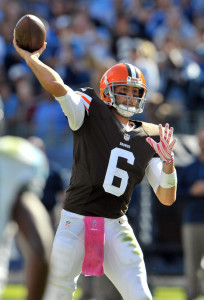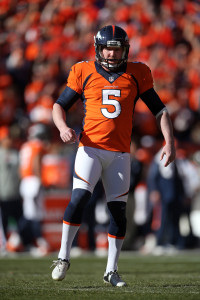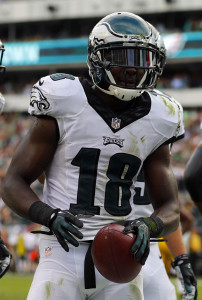It may seem like a lifetime ago now, but we’re only a few weeks removed from a time when the daily exploits of Johnny Manziel were consistently among the NFL’s hottest stories. Whether it was the rookie quarterback being spotted with a rolled-up dollar bill in Las Vegas or giving the middle finger to the Washington sideline during a preseason game, Manziel was making headlines all summer.
Five weeks into the regular season, Ray Rice, Adrian Peterson, Greg Hardy, and several other black eyes for the NFL likely have the league longing for the days when Manziel was its biggest newsmaker. But it’s not just those stories that have knocked the 22nd overall pick out of the news cycle. While many observers believed Manziel would’ve assumed the starting role in Cleveland by now, the former Heisman winner has only seen the field for the occasional gimmick play, having being otherwise sidelined by the strong play of veteran starter Brian Hoyer.
As Adam Caplan of ESPN.com noted this week (via Twitter), Hoyer’s agent Joe Linta and the Browns had just one conversation about the QB’s contract status prior to the season, following the draft. Although we heard at the time that the team had interest in extending Hoyer’s deal, Caplan says (via Twitter) that the two sides were far apart. However, the ESPN.com scribe believes that Hoyer’s play through Cleveland’s first four games will “eventually bring both sides together for an extension.”
Hoyer, who turns 29 next Monday, hasn’t exactly been maintaining a Peyton Manning-esque pace through his first four contests this season, but his numbers are very solid — the Michigan State product has completed 62.1% of his passes, is averaging more than 250 yards per game, and has thrown just one interception to go along with his six TD passes.
Most importantly, for a Cleveland team that was expected to occupy the cellar in the AFC North, Hoyer has engineered big wins over the Saints and Titans, leading fourth-quarter comebacks in both games. The Browns still face an uphill battle in a division that features the 3-1 Bengals, as well as the 3-2 Ravens and Steelers, but combined with his 3-0 record as a starter last season, Hoyer’s record so far this year shows that he’s capable of earning victories that many NFL starting QBs wouldn’t.
Assuming Hoyer’s strong play continues, an extension certainly seems within the realm of possibility. But there was a reason the two sides were far apart in the offseason, and there’s a reason that former Browns CEO Joe Banner refers to it as “one of the toughest contract decisions on both sides” that he has ever seen (Twitter link). With Manziel in the mix, it’s still not clear if Hoyer projects as Cleveland’s long-term starter, which is presumably how he’ll want to be paid. Knowing they have the inexpensive Manziel as a fall-back option, the Browns won’t be eager to break the bank for Hoyer, and an extension would mean risking having him turn into the NFL’s most overpaid backup.
The uncertainty about Hoyer’s long-term role is the primary reason why both sides may be inclined to keep extension discussions on hold for now, but it’s still worth examining what sort of figures Hoyer’s camp and the Browns might propose if negotiations take place during the season. The former Patriot will certainly be in line for a raise on 2014’s modest $1MM base salary, but by how much?
One point of comparison for the Browns may be Kyle Orton‘s two-year, $11MM deal with the Bills. Orton is the starter in Buffalo now, but when he was signed, the team regarded him as a backup to E.J. Manuel. At an average rate of $5.5MM per year, Orton was paid more than virtually every other backup in the league because the Bills recognized that a change may be necessary if the erratic Manuel struggled out of the gates.
Josh McCown‘s two-year, $10MM contract with the Buccaneers is a similar pact, though Tampa Bay viewed McCown as its starter heading into the season. The former Bear earned that deal after a brief, successful run as the starter in Chicago — while his numbers during that 2013 stretch were fantastic, a combination of his age and his mediocre career production kept the overall value of the pact in check.
Unlike Orton and McCown though, Hoyer is on the right side of age 30, and is showing he’s capable of acting as more than just the caretaker of an offense. His track record may not be extensive, but Hoyer has never been given the opportunity to prove himself as a starter, and now that he’s getting that chance, he’s proving he shouldn’t be moved down the depth chart anytime soon. If the Browns aren’t willing to offer him fair market value, other teams will be interested in the offseason, and assuming his play doesn’t fall off a cliff over the remainder of the season, Hoyer should be able to land a deal worth more than Orton’s or McCown’s on the open market.
From Linta’s perspective, it’s difficult to point to another player that represents a logical comparable for his client. Few quarterbacks have Hoyer’s combination of talent and inexperience at age 29, and that lack of a track record will almost certainly keep the Browns quarterback from landing a top-15 kind of deal. Perhaps a multiyear contract in the range of $8-10MM per year will make sense for Hoyer — as Over the Cap’s data shows, that’s currently a no-man’s land on the quarterback market, with no contracts averaging anything between Carson Palmer‘s $8MM and Tom Brady‘s $11.4MM.
Ultimately, it seems the Browns could be forced to make a decision between Hoyer or Manziel, and considering what a black hole the quarterback position has been for the team for the last several years, there’s no need to rush that decision. It makes sense for the Browns to wait until season’s end to see what they have in Hoyer. At that point, an extension could make a lot of sense for Cleveland. Even if the club intends to give Manziel an opportunity in the near future, he’ll be on an affordable rookie contract for several more seasons — that means there will be flexibility under the cap to pay Hoyer and potentially move on from Hoyer’s contract if and when Manziel proves he should be the No. 1 option in Cleveland.


